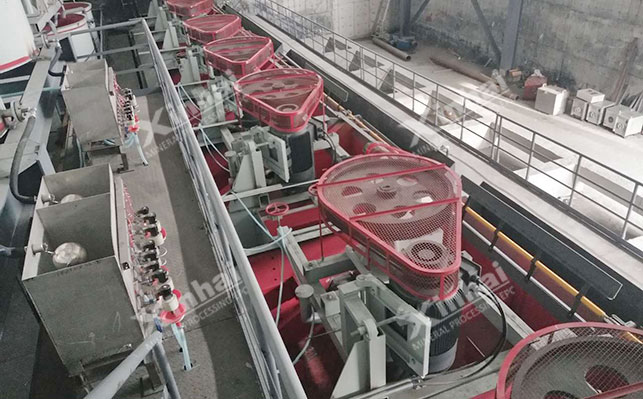Encapsulated gold is a type of gold ore. The characteristic of this type of gold ore is that the gold ore is tightly encapsulated with other minerals, which creates a great difficulty for gold extraction. The gold minerals in the encapsulated gold may be encapsulated by minerals such as sulfides, quartz, and silicates. Among them, the encapsulated gold encapsulated in sulfide ores accounts for a large proportion. So, in what aspects are the difficulties in encapsulated gold beneficiation reflected? How to carry out encapsulated gold beneficiation and gold extraction?
1.1. Gold minerals are encapsulated in other minerals and are difficult to contact with leaching agents, which affects the leaching rate of gold;
1.2. There may be oxygen-consuming and cyanide-consuming minerals, which will consume a large amount of cyanide and dissolved oxygen, affecting the oxidation and leaching of gold;
1.3. The surface of gold particles may be passivated, forming sulfide films, peroxide films, etc., which reduce the oxidation and leaching rate of the gold particle surface;
1.4. There may be "gold robbery" effects such as carbonaceous materials, which make the leached gold return to the leaching residue;
1.5. Gold may exist in the form of insoluble gold compounds, which are difficult to leach.
2.1. Gravity separation method
If the ore size is coarse and the specific gravity difference is large, gravity separation can be considered. Gravity separation uses the difference in specific gravity between minerals to achieve gold enrichment through gravity separation. In the beneficiation of placer gold, gravity separation has a better effect. It is widely adaptable to common gold mines such as Yellow River placer gold, and has low investment, high extraction rate and simple operation.

2.2. Flotation method
For fine-grained, sulfide-containing rock gold mines, flotation is a more appropriate choice. Flotation separates gold from gangue minerals by selectively adsorbing reagents on the surface of gold particles. Before flotation, the ore needs to be fully ground to make the gold ore particle size suitable for flotation. According to the different mineral compositions in the ore, suitable collectors and regulators can be selected to improve the recovery rate of gold.
Common process flow of flotation method:
(1) Grinding
The grinding process is a two-stage closed-circuit grinding process, which makes the gold-bearing minerals and gangue minerals as monomeric as possible.
In order to achieve the monomeric separation of gold-bearing minerals and gangue minerals, a two-stage closed-circuit grinding process is adopted. First, the particles are fed into the grate ball mill for coarse grinding, and then fed into the cyclone for classification. The overflow returns to the grate ball mill for further grinding, and the bottom flow is fed into the overflow ball mill for fine grinding. Through this process, the final grinding particle size can reach 0.038mm, accounting for 82.10%, creating good conditions for the subsequent flotation process.
(2) Flotation
The flotation process is a two-stage concentrating-two-scavenging open-circuit process. Select sulfide ore collectors, such as butyl xanthate, butyl ammonium black medicine, etc. Use CaO as a pH adjuster and CuSO₄ as an activator.
In the flotation stage, a two-stage concentrating-two-scavenging open-circuit process is adopted. Since gold mainly exists in the form of sulfide-encapsulated gold, quartz silicate-encapsulated gold, and natural gold, it is reasonable to choose a sulfide collector. Sulfide collectors such as butyl xanthate and butyl ammonium black medicine can effectively adsorb gold minerals and improve the recovery rate of gold. At the same time, using CaO as a pH adjuster to adjust the pH value of the slurry to 10.5, and using CuSO₄ as an activator can enhance the floatability of gold minerals. During the flotation process, it is also necessary to feed a certain amount of water glass, butyl xanthate, butyl ammonium black medicine and No. 2 oil for flotation operations. Finally, a gold concentrate with a gold grade of 162.50g/t and a gold recovery rate of 60.01% can be obtained.
2.3. Cyanidation method
The cyanidation method is suitable for ores with a high degree of oxidation, fine gold particles or complex occurrence. This method uses a cyanide solution to react chemically with gold to extract gold from the ore. There are many processes for extracting gold and silver by cyanidation, such as tank leaching cyanidation, heap leaching cyanidation, zinc wire replacement, zinc powder replacement, activated carbon adsorption, ion exchange resin, electrolytic deposition, magnetic carbon method, etc. You can choose the appropriate method according to the specific situation.

2.4. Carbon-in-Pulp Method
The carbon-in-pulp method is an improved process for cyanide gold extraction. It combines cyanide leaching with adsorption process and is suitable for gold mines with low gold content and complex minerals. The carbon-in-pulp method is divided into CIP and CIL. The main difference is whether the adsorption is carried out simultaneously during the leaching process. This method can shorten the process and is suitable for the extraction of large, low-grade gold mines.
2.5. Heap Leaching Method
The heap leaching method is mainly used to treat low-grade gold ores with high oxidation degree and low gold content. This method has low investment and simple operation, but the leaching cycle is long. The gold ore is crushed to a suitable particle size and piled up in the yard. The cyanide solution is evenly poured into the ore pile by spraying or dripping to gradually dissolve the gold minerals. Then the gold-containing solution is collected for desorption and electrolysis, and finally the gold is recovered.
In the selection of mineral processing methods, the encapsulated gold should be tested for mineral processing first to determine the composition and characteristics of the encapsulated gold ore, and targeted mineral processing methods should be adopted to gradually separate the gangue minerals to achieve the purpose of gold extraction. Only in this way can high-grade gold concentrate be obtained and the mineral processing recovery rate be improved.